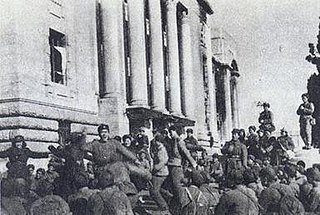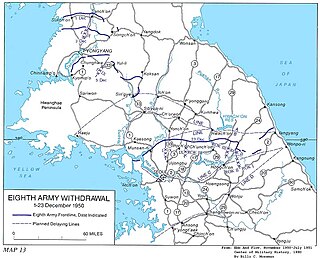
The Battle of Inchon, also spelled Battle of Incheon, was an amphibious invasion and a battle of the Korean War that resulted in a decisive victory and strategic reversal in favor of the United Nations Command (UN). The operation involved some 75,000 troops and 261 naval vessels and led to the recapture of the South Korean capital of Seoul two weeks later. The code name for the Inchon operation was Operation Chromite.

Operation Ripper, also known as the Fourth Battle of Seoul, was a United Nations (UN) military operation conceived by the US Eighth Army, General Matthew Ridgway, during the Korean War. The operation was intended to destroy as much as possible of the Chinese People's Volunteer Army (PVA) and Korean People's Army (KPA) forces around Seoul and the towns of Hongch'on, 50 miles (80 km) east of Seoul, and Chuncheon, 15 miles (24 km) further north. The operation also aimed to bring UN troops to the 38th Parallel. It followed upon the heels of Operation Killer, an eight-day UN offensive that concluded February 28, to push PVA/KPA forces north of the Han River. The operation was launched on 6 March 1951 with US I Corps and IX Corps on the west near Seoul and Hoengsong and US X Corps and Republic of Korea Army (ROK) III Corps in the east, to reach the Idaho Line, an arc with its apex just south of the 38th Parallel in South Korea.

The Battle of the Pusan Perimeter, known in Korean as the Battle of the Naktong River Defense Line, was a large-scale battle between United Nations Command (UN) and North Korean forces lasting from August 4 to September 18, 1950. It was one of the first major engagements of the Korean War. An army of 140,000 UN troops, having been pushed south to the brink of defeat, were rallied to make a final stand against the invading Korean People's Army (KPA), 98,000 men strong.

The Battle of P'ohang-dong was an engagement between the United Nations Command (UN) and North Korean forces early in the Korean War, with fighting continuing from 5–20 August 1950 around the town of P'ohang-dong, South Korea. It was a part of the Battle of Pusan Perimeter, and was one of several large engagements fought simultaneously. The battle ended in a victory for the UN after their forces were able to drive off an attempted offensive by three North Korean Korean People's Army (KPA) divisions in the mountainous eastern coast of the country.

The Battle of Taegu was an engagement between United Nations Command (UN) and North Korean forces early in the Korean War, with fighting continuing from August 5–20, 1950 around the city of Taegu, South Korea. It was a part of the Battle of Pusan Perimeter, and was one of several large engagements fought simultaneously. The battle ended in a victory for the UN after their forces were able to drive off an offensive by Korean People's Army (KPA) divisions attempting to cross the Naktong River and assault the city.

The Third Battle of Seoul was a battle of the Korean War, which took place from December 31, 1950, to January 7, 1951, around the South Korean capital of Seoul. It is also known as the Chinese New Year's Offensive, the January–Fourth Retreat or the Third Phase Campaign Western Sector.

In the Battle of the Bowling Alley , United Nations Command (UN) forces defeated North Korean forces early in the Korean War near the city of Taegu, South Korea. The battle took place in a narrow valley, dubbed the "Bowling Alley", which was north of Taegu. It followed a week of fighting between the Korean People's Army (KPA) 13th Division and the Republic of Korea Army's (ROK) 1st Division along the latter's last defensible line in the hills north of the city. Reinforcements, including the US Army's 27th and 23rd Infantry Regiments were committed to bolster the ROK defenses. This battle and several others were smaller engagements of the Battle of Pusan Perimeter.

The First and Second Battles of Wonju, also known as the Wonju Campaign or the Third Phase Campaign Eastern Sector, was a series of engagements between North Korean and United Nations (UN) forces during the Korean War. The battle took place from December 31, 1950, to January 20, 1951, around the South Korean town of Wonju. In coordination with the Chinese capture of Seoul on the western front, the North Korean Korean People's Army (KPA) attempted to capture Wonju in an effort to destabilize the UN defenses along the central and the eastern fronts.

The Battle of Sangju was an engagement between the United Nations and North Korean forces, occurring on July 20–31, 1950, in the village of Sangju in southern South Korea, early in the Korean War. It ended in a victory for the North Korean forces after they were able to push troops of the United States and South Korea out of the area.
The Battle of Hwanggan was an engagement between United States and North Korean forces that took place on July 23–29, 1950, on a road north of the village of Hwanggan in southern South Korea, early in the Korean War. The battle ended in a victory for the North Koreans after US troops were forced to withdraw south.

The Great Naktong Offensive was a North Korean military offensive against United Nations Command (UN) forces early in the Korean War, taking place from September 1–15, 1950. It was the North Korean Korean People's Army (KPA)'s unsuccessful final bid to break the Pusan Perimeter established by the UN forces.
Operation Pokpung was the military invasion of the Republic of Korea (ROK) by the Democratic People's Republic of Korea (DPRK) that triggered the Korean War. The DPRK military began the offensive by crossing the 38th parallel north and entering ROK territory at 04:00 PYT/KST on 25 June 1950; the DPRK government did not issue any declaration of war before the invasion.

The Chinese spring offensive, also known as the Chinese Fifth Phase Offensive, was a military operation conducted by the Chinese People's Volunteer Army (PVA) during the Korean War. Mobilizing three field armies totaling 700,000 men for the operation, the Chinese command conducted their largest offensive operation since their Second Phase Offensive in November and December 1950. The operation took place in the summer of 1951 and aimed at permanently driving the United Nations Command (UN) forces off the Korean peninsula.

The Battle of the Soyang River, also referred to as the "May Massacre", or Battle of Hyeon-ri in Korean and Chinese was fought during the Korean War between United Nations Command (UN) and the Chinese People's Volunteer Army (PVA) and Korean People's Army (KPA) during the Spring Offensive of April–May 1951. The attack took place across the entire front but with the main thrust below the Soyang River in the Taebaek Mountains. The objective of the main effort was to sever the six Republic of Korea Army (ROK) divisions on the eastern front from the remainder of the US Eighth Army and annihilate them and the US 2nd Infantry Division. Secondary attacks would be mounted by PVA and KPA forces across the entire front.

The UN May–June 1951 counteroffensive was a military operation performed by the United Nations Command (UN) during the Korean War launched in response to the Chinese spring offensive of April-May 1951. It was the final large-scale offensive of the war that saw significant territorial changes.

The Third Battle of Wonju, was a series of engagements between North Korean and United Nations (UN) forces during the Korean War. The battle took place from 13 to 18 February 1951 north of the South Korean town of Wonju.

The Pusan Perimeter offensive was a large-scale offensive by United Nations Command (UN) forces against North Korean forces commencing on 16 September 1950.
The UN offensive into North Korea was a large-scale offensive in late 1950 by United Nations (UN) forces against North Korean forces during the Korean War.

The UN Forces retreat from North Korea was the withdrawal of United Nations (UN) forces from North Korea that took place from 2–25 December 1950.
The Operation Western Region was a defensive operation conducted by the Republic of Korea Armed Forces (ROK) between 25 and 28 June 1950 against the Operation Pokpung of the Korean People's Army (KPA) during the beginning of the Korean War. On 25 June 1950, the KPA I Corps launched a surprising attack on the ROK forces located in the western region of the 38th Parallel. The ROK delayed the KPA advance and created conditions for the United Nations to participate early, but lost territories in Ongjin Peninsula and cities nearby Seoul.















